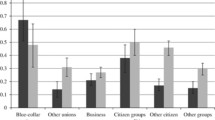Conclusion and summary
We have constructed two models of how economic interest groups allocate their campaign monies between candidates for the same legislative house. The models make contrasting assumptions regarding an interest group's strategy for affecting policy outcomes. One model assumes contributions are given to affect election probabilities while the other assumes that contributions are exchanged for political favors. The validity of these assumptions can best be examined by testing the predictions of the two models.
The contribution functions of seven economic interest groups to 1974 candidates for the U.S. House were estimated with Tobit analysis. A beta functional form was used, with expected vote percentage and voting score as independent variables. For all seven groups, the mode of this function was significantly different from fifty percent of the expected vote, supporting the prediction that economic contributors prefer likely winners. This result tends to support the assumption that an economic interest group contributes in order to obtain political favors, not to affect electoral outcomes. Although we cannot exclude the possibility that some mixed strategy is followed, the strategy described by the exchange model appears to have dominated economic interest group giving in the 1974 U.S. House races.
Similar content being viewed by others
References
Abrams, B.B., and Settle, R.F. (1976). ‘The Effect of Broadcasting on Political Campaign Spending: An Empirical Investigation’, Journal of Political Economy 84 (October): 1095–1108.
Amemiya, T. (1973). ‘Regression Analysis When the Dependent Variable is Truncated Normal’, Econometrica 41 (November): 997–1016.
Bental, B., and Ben-Zion, U. (1975). ‘Political Contribution and Policy — Some Extensions’, Public Choice 24 (Winter): 1–12.
Ben-Zion, U., and Eytan, Z. (1974). ‘On Money, Votes, and Policy in a Democratic Society’, Public Choice 17 (Spring): 1–10.
Boulding, K.E. (1973). The Economy of Love and Fear: A Preface to Grants Economics, Belmont, Calif.: Wadsworth, ch. 2.
Common Cause (1976). Campaign Finance Monitoring Project. Xerox.
Congressional Quarterly (1974). ‘Labor in Politics: Optimism about 1974 Campaigns’, 32 (June 8): 1473–1478.
Cook, W.D., Kirby, M.J.L., and Mehndiratta, S.L. (1974). ‘Models for the Optimal Allocation of Funds over N Constituencies During an Election Campaign’, Public Choice 20 (Winter): 1–16.
Crain, W.M., and Tollison, R.D. (1977). ‘Campaign Expenditures and Political Competition’, Journal of Law and Economics 19 (April): 177–188.
Crain, W.M., et al. (1977). ‘Legislators as Taxicabs: On the Value of Seats in the U.S. House of Representatives’, Economic Inquiry 15 (April): 298–302.
Dawson, P.A., and Zinser, J.E. (1976). ‘Political Finance and Participation in Congressional Elections’, Annals of the American Academy of Political and Social Science 425 (May): 59–73.
Federal Election Committee (1977). FEC Disclosure Series No. 9: 1976 House of Representatives Campaigns, Receipts and Expenditures, Washington, D.C.
Frey, B.S., and Schneider, F. (1978). ‘An Empirical Study of Politico-Economic Interaction in the U.S.’, Review of Economics and Statistics 60 (May): 174–183.
Johnson, N.L., and Kitz, S. (1970). Continuous Univariate Distributions — 2. Boston, Houghton Mifflin Co.
Lydon, C. (1974). ‘Labor Again Talks of Democrats Gaining More Than 40 Seats in House Elections’, New York Times October 1: 21.
McKeough, K.L. (1970). ‘Financing Campaigns for Congress: Contribution Patterns of National-Level Party and Non-Party Committees, 1964’, Princeton: Citizens' Research Foundation.
Milbrath, L.W. (1963). The Washington Lobbyists. Chicago: Rand McNally.
Mintz, M. (1974). ‘AMA Gave $1.5 Million to Candidates’, Washington Post, 27 October: A1, A12.
Nelson, P. (1976). ‘Political Information’, Journal of Law and Economics 19 (August): 315–316.
Pittman, R. (1976). ‘The Effects of Industry Concentration and Regulation on Contributions in Three 1972 U.S. Senate Campaigns’, Public Choice 27 (Fall): 71–80.
Pittman, R. (1977). ‘Market Structure and Campaign Contributions’, Public Choice 31 (Fall): 37–52.
Rosenbaum, D.E. (1974). ‘Teacher Groups Increase Election Campaign Outlay’, New York Times 22 September: 1, 30.
Sankoff, D. and Mellos, K. (1972). ‘The Swing Ratio and Game Theory’, American Political Science Review 66 (June): 551–554.
Scoble, H. (1967). Ideology and Electoral Action. San Francisco: Chandler Pub. Co.
Silberman, J.I., and Durden, G.C. (1976). ‘Determining Legislative Preferences on the Minimum Wage: An Economic Approach’, Journal of Political Economy 84 (April): 317–329.
Stigler, G.T. (1971). ‘The Theory of Economic Regulation’, Bell Journal of Economics and Management Science 2 (Spring): 3–21.
Tobin, J. (1958). ‘Estimation of Relationships for Limited Dependent Variables’, Econometrica 26 (January): 24–36.
Tolchin, M. (1978). ‘Corporate Use of Political Action Panels Growing’, New York Times 128 (April 19): A14.
Tullock, G. (1972). ‘The Purchase of Politicians’, Western Economic Journal 10 (September): 354–355.
Wasby, S. (1968). ‘National Party Contributions to Non-Incumbent Candidates: The Democrats in 1964’, Social Science Quarterly 48: 573–585.
Weaver, W., Jr. (1976). ‘Election Panel Gets Six Complaints’, New York Times 126 (October 27): 19.
Weaver, W., Jr. (1978). ‘Special Interests Spend $60 Million’ New York Times 128 (November 7): A27.
Welch, W.P. (1974). ‘The Economics of Campaign Funds’, Public Choice 20 (Winter): 83–99.
Welch, W.P. (1976). ‘The Effectiveness of Expenditures in State Legislative Races’, American Politics Quarterly 4 (July): 333–356.
Welch, W.P. (1977). Resources in Political Campaigns: A Unified Theory, Ph.D. thesis, University of Colorado.
Wright, G. (1974). ‘Political Economy of New Deal Spending: An Econometric Analysis’, Review of Economics and Statistics 56 (February): 30–38.
Author information
Authors and Affiliations
Additional information
This article is a revision of part of the author's doctoral dissertation at the University of Colorado. He wishes to thank his wife, Robert McNown, Gordon Tullock, Robert Wichers, and especially Jack Ochs for helpful comments on earlier drafts and the Social Science Computer Research Institution, K.Y. Chang, and the Brookings Institution for computational assistance. The usual caveat applies.
Rights and permissions
About this article
Cite this article
Welch, W.P. The allocation of political monies: Economic interest groups. Public Choice 35, 97–120 (1980). https://doi.org/10.1007/BF00154752
Issue Date:
DOI: https://doi.org/10.1007/BF00154752




